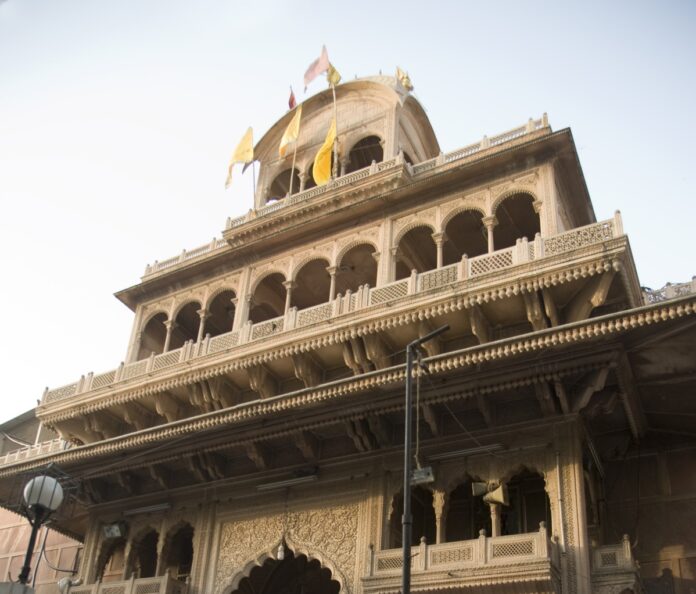Banke Bihari Mandir
The Banke Bihari Mandir, located in the holy city of Vrindavan in the Mathura district of Uttar Pradesh, India, is one of the most famous and revered temples dedicated to Lord Krishna.
Banke Bihari Mandir History
The temple’s history dates back to the 19th century when it was built in the year 1864. The temple is closely associated with the great saint and poet, Swami Haridas, who was a passionate devotee of Lord Krishna.
Swami Haridas was an ardent musician and a disciple of Saint Tansen, the legendary court musician of Emperor Akbar. According to legend, Swami Haridas was visited by Lord Krishna in the form of a young child who would frequently visit him to listen to his soul-stirring music. It is believed that Lord Krishna blessed Swami Haridas and granted him the deity of Banke Bihari, which was later enshrined in the temple.
Also Read: Mankamneshwar Mandir Lucknow All You Need to Know
Since its establishment, Banke Bihari Mandir has become a significant pilgrimage site for devotees of Lord Krishna. The temple is renowned for its unique tradition of “Phool Bangla Seva” where the deity is surrounded by a magnificent structure made of flowers. The ambiance of the temple is distinctly divine and serene, attracting devotees from all over the world.
Banke Bihari Mandir Timings
The temple follows a specific schedule for devotees to seek the blessings of Lord Krishna. Here are the timings for various rituals and darshan at Banke Bihari Mandir:
- Mangala Aarti – This early morning ritual takes place at 8:00 AM, marking the first darshan of the deity.
- Shringar Aarti – This beautiful adornment ceremony is performed at 9:00 AM.
- Rajbhog Aarti – The midday offering ceremony is conducted at 12:00 PM.
- Gwal Aarti – This evening Aarti takes place around 6:30 PM, attracting a large number of devotees.
- Sandhya Aarti – The evening Aarti is performed at 7:30 PM, accompanied by devotional songs and chants.
- Thakur Ji’s resting time – From 8:30 PM to 9:30 PM, Lord Krishna takes a rest in the temple.
- Shayan Aarti – This final Aarti of the day signifies that Lord Krishna is retiring for the night. It takes place at 9:30 PM.
Please note that these timings may vary on festival days and special occasions. Devotees are advised to confirm the timings before their visit to ensure they don’t miss any of the divine rituals.
How to Reach Banke Bihari Mandir Vrindavan
Banke Bihari Mandir is conveniently located in the heart of Vrindavan. Here are the various modes of transportation that you can choose to reach the temple:
By Air
The nearest airport to Vrindavan is the Indira Gandhi International Airport in Delhi, which is well-connected to major cities across the world. From the airport, you can hire a taxi or take a bus to Vrindavan. The distance between Delhi and Vrindavan is approximately 180 kilometers, and it takes around 4 hours to reach by road.
By Train
Vrindavan has its own railway station called the “Vrindavan Junction.” However, it has limited train connectivity. Alternatively, you can reach the Mathura Junction railway station, which is only 10 kilometers away from Vrindavan. From Mathura, you can hire a taxi, an auto-rickshaw, or take a bus to reach Banke Bihari Mandir in Vrindavan.
By Road
Vrindavan is well-connected by road, and there are regular bus services run by UPSRTC from major cities like Delhi, Agra, Mathura, and other nearby towns. You can also drive to Vrindavan if you have your vehicle. The city is easily accessible via the National Highway 44.
Local Transportation
Once you reach Vrindavan, the preferred mode of local transportation is cycle-rickshaws, e-rickshaws, or auto-rickshaws, which are readily available throughout the city. These modes of transport are ideal for navigating through the narrow lanes and reaching the Banke Bihari Mandir, as well as other famous temples and attractions in Vrindavan.
Visiting the Banke Bihari Mandir in Vrindavan is a spiritually enriching experience and a must for devotees of Lord Krishna. With its rich history, divine ambiance, and unique rituals, the temple remains a true testament to the devotion and love exhibited by its followers for centuries.
Legends and Significance
Banke Bihari Mandir holds immense significance among Krishna devotees due to its association with Swami Haridas and the divine tales surrounding it. The temple is believed to be the place where Lord Krishna, in the form of Banke Bihari, reveals himself and interacts with his devotees.
Legend has it that the deity of Banke Bihari was originally worshiped in Nidhivana, a sacred forest where Lord Krishna and Radha would meet and exchange love in secrecy. Swami Haridas was a witness to these divine moments and composed beautiful melodies to express his devotion. It is said that Lord Krishna, enchanted by his music, would come in human form to listen to the celestial tunes.
The idol of Banke Bihari in the temple is unique and depicts Lord Krishna in a tribhanga posture, with his body gracefully bent in three places. The deity’s black stone complexion and the ornamentation of the idol make it an exquisite sight. The temple’s architecture reflects traditional North Indian styles and features intricate carvings and vibrant paintings depicting episodes from Lord Krishna’s life.
Festivals and Celebrations
Banke Bihari Mandir witnesses a grand celebration of various festivals dedicated to Lord Krishna. Some of the most prominent festivals celebrated here include:
- Janmashtami: This is the grand celebration of Lord Krishna’s birth, which attracts thousands of devotees to the temple. The temple is adorned with lights, flowers, and colorful decorations, and special rituals and performances are held throughout the day and night.
- Radhashtami: This festival marks the appearance day of Radha, Lord Krishna’s eternal consort. Devotees gather at the temple to seek the blessings of Radha Rani and participate in devotional singing and dancing.
- Holi: The festival of colors, Holi, is celebrated with great joy and enthusiasm at the Banke Bihari Mandir. Devotees come together to throw colored powders and sing and dance in a joyous mood, imitating the playful interactions between Radha and Krishna.
- Jhulan Yatra: During this festival, which falls in the month of Shravana (July/August), swings (jhulans) are beautifully decorated, and the deities of Radha and Krishna are placed on them. Devotees take turns in swinging the deities and offer prayers for divine blessings.
- Annakoot: This festival signifies the offering of food to the deities as a symbol of gratitude for the bountiful harvest. A mountain of food is prepared and placed before the deities, and later the prasad (blessed food) is distributed among the devotees.
Tips for Visiting Banke Bihari Mandir
- Be mindful of the dress code: It is advisable to dress modestly and conservatively while visiting the temple. Men are expected to wear shirts and trousers, while women should wear sarees or modestly covered outfits. Avoid wearing shorts or revealing clothing.
- Avoid weekends and peak hours: The temple witnesses a larger influx of devotees on weekends and during festival times. If you prefer a quieter and more serene experience, consider visiting on weekdays or during less crowded hours.
- Respect temple traditions: Remove your footwear before entering the temple premises, and be respectful of the rituals and customs practiced by the priests and devotees. Maintain silence and avoid personal conversations or distractions during darshan (viewing of the deity).
- Photography restrictions: Photography is generally not allowed inside the temple. Respect the sanctity of the place and refrain from taking pictures unless explicitly permitted.
- Beware of touts: While visiting tourist destinations, one must remain cautious of touts and unauthorized guides who may try to exploit unsuspecting travelers. Stick to official guides or trusted sources of information to avoid any inconvenience.
Shopping and Nearby Attractions
Apart from offering a spiritual experience, a visit to Banke Bihari Mandir provides an opportunity for shopping and exploring the vibrant culture of Vrindavan. Here are a few popular activities and nearby attractions that you can explore during your visit:
- Shopping for Souvenirs: Vrindavan is known for its rich heritage of handicrafts and religious artifacts. Take a stroll through the bustling streets surrounding the temple, and you’ll find a wide range of items such as intricately carved wooden mementos, silk garments, beautiful idols of Lord Krishna, and devotional music CDs.
- Explore Other Temples: Vrindavan is home to numerous other temples dedicated to Lord Krishna and his incarnations. Some notable temples worth visiting include the Prem Mandir, ISKCON Temple, Radha Raman Temple, and Radha Vallabh Temple. Each temple has its own unique vibe and architectural style, offering a diverse spiritual experience.
- Relish Local Cuisine: Don’t miss the opportunity to indulge in the delicious vegetarian cuisine available in Vrindavan. Try the famous “Chappan Bhog,” a platter comprising 56 different food items offered to Lord Krishna. Also, taste the local sweets like peda and laddu, which are specialties of the region.
- Visit Yamuna River: The sacred Yamuna River flows near Vrindavan, and a visit to its ghats (river banks) can be a serene experience. Take a boat ride or just sit by the river, soaking in the peaceful atmosphere and offering prayers to the holy river.
- Attend Bhajan and Kirtan Sessions: Many temples in Vrindavan organize bhajan and kirtan sessions, where devotees come together to sing devotional songs in praise of Lord Krishna. Participating in these sessions can be a soul-stirring and uplifting experience.
Visiting Banke Bihari Mandir offers an opportunity to immerse oneself in the devotion and spirituality associated with Lord Krishna. The historical significance, divine atmosphere, and rich cultural heritage of the temple make it a must-visit destination for spiritual seekers and Krishna devotees from across the globe. The enchanting music and captivating aura of the temple create a sense of tranquility and devotion, providing a unique experience that stays with the visitors long after they leave.





